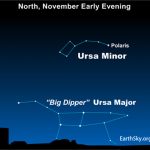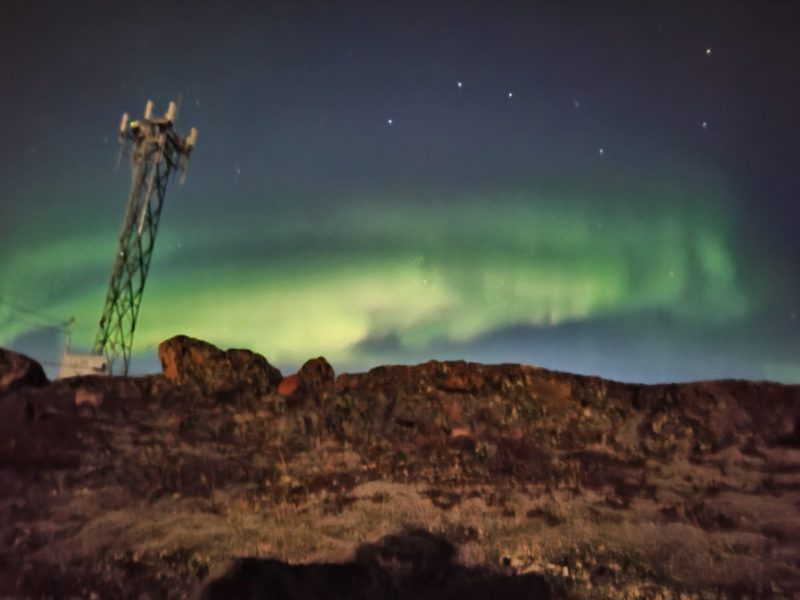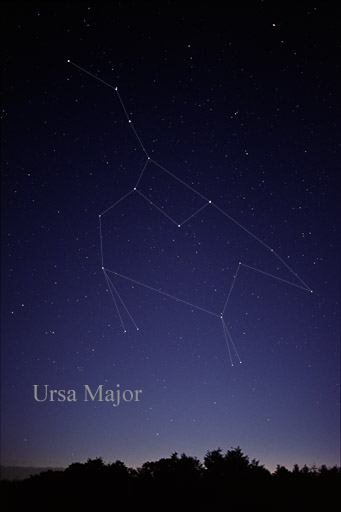
Tonight … a constellation you might or might not see, depending on your latitude. In our western skylore, the Big Dipper is part of the constellation Ursa Major, otherwise known as the Great Bear. But to the Mi’kmaq, an indigenous First Nations people living in southeastern Canada, a celestial Bear – our same familiar Big Dipper pattern – coming down to Earth signaled the start of hibernation season. This is when earthly bears return to their dens, and when the sap of trees returns to the warm womb of the underworld.
In her birding blog called BeakingOff, Shyloh – who describes herself as “living in the Yukon Territory” – tells the Mi’kmaq story of the Bear. She writes that the Mi’kmaq story explains:
… why Ursa Major (The Big Dipper) moves and changes its position between fall and spring. Ursa Major is known to some as the Bear. This is because the four stars that create the ‘pot’ of the Big Dipper look like a large animal, one star being the head, another being the tail, one for the right front leg, and another for the right back leg. The Mi’kmaq First Nations used to call Ursa Major the Bear, and thought that the Corona Borealis looked like the Bear’s cave. Following the Bear are seven stars: the three stars that create the handle of the Big Dipper, and four stars from Bootes. These seven stars were thought to be birds hunting the Bear: Robin, Chickadee, Moosebird (a.k.a Gray Jay), Pigeon, Blue Jay, Owl (some sources say Great Horned Owl), and Saw-whet Owl.

View larger. | The Bear and her hunters, in the Micmac tradition. Image via Sana Kavanagh/ GreenTeacher.
In this sky lore, hunters catch Celestial Bear each year in the fall, and it’s the dripping blood from the Bear that colors the autumn landscape. But, as Shyloh explains in her blog:
… this is not the end of Bear’s story.
All winter, her skeleton lies on its back, but her spirit has entered another bear who also lies upon her back in the den, invisible, and sleeping the winter sleep. When the spring comes around again, this bear will again leave the den, will again be hunted and then killed. And her spirit will enter the net bear sleeping in the den.
So this cycle repeats each spring, when the sun awakens the sleeping earth.
Read more from Shyloh: Mi’kaq story of the stars

View at EarthSky Community Photos. | Ariel Atienza in Iqaluit, Nunavut, Canada, captured the Big Dipper and a green aurora on September 30, 2020.
In the Northern Hemisphere, the Big Dipper is probably the sky’s best known asterism – not an official constellation – but an extremely recognizable pattern of stars. But it’s harder to see the Dipper in the evening at this time of year than at any other time. Every year, the Big Dipper (Great Bear) descends to its lowest point in the sky on November evenings.
In fact, people in the southern part of the United States can’t see the Big Dipper in the evening right now, because it swings beneath their northern horizon.
Even in the northern states, the Big Bear is hard to spot. The Big Dipper skims along the northern horizon in the evening, ducking behind any obstructions such as trees or mountains.
And, of course, it can’t be seen in the evening from Southern Hemisphere latitudes now either.
But take heart, for the Bear will return in spring!
EarthSky lunar calendars are cool! They make great gifts. Order now. Going fast!

Image via AlltheSky.com.
Bottom line: The Big Dipper is difficult, or impossible, to see on November evenings. If you’re in the southern U.S. or a similar latitude around the world, the Dipper is below your northern horizon in the evening now. If you’re in the northern U.S. or a similar latitude, the Big Dipper may be above your horizon in the evening, but it will be low in the northern sky.
Read more: The History of the Newfoundland Mi’kmaq
Donate: Your support means the world to us
from EarthSky https://ift.tt/2DfQDbF

Tonight … a constellation you might or might not see, depending on your latitude. In our western skylore, the Big Dipper is part of the constellation Ursa Major, otherwise known as the Great Bear. But to the Mi’kmaq, an indigenous First Nations people living in southeastern Canada, a celestial Bear – our same familiar Big Dipper pattern – coming down to Earth signaled the start of hibernation season. This is when earthly bears return to their dens, and when the sap of trees returns to the warm womb of the underworld.
In her birding blog called BeakingOff, Shyloh – who describes herself as “living in the Yukon Territory” – tells the Mi’kmaq story of the Bear. She writes that the Mi’kmaq story explains:
… why Ursa Major (The Big Dipper) moves and changes its position between fall and spring. Ursa Major is known to some as the Bear. This is because the four stars that create the ‘pot’ of the Big Dipper look like a large animal, one star being the head, another being the tail, one for the right front leg, and another for the right back leg. The Mi’kmaq First Nations used to call Ursa Major the Bear, and thought that the Corona Borealis looked like the Bear’s cave. Following the Bear are seven stars: the three stars that create the handle of the Big Dipper, and four stars from Bootes. These seven stars were thought to be birds hunting the Bear: Robin, Chickadee, Moosebird (a.k.a Gray Jay), Pigeon, Blue Jay, Owl (some sources say Great Horned Owl), and Saw-whet Owl.

View larger. | The Bear and her hunters, in the Micmac tradition. Image via Sana Kavanagh/ GreenTeacher.
In this sky lore, hunters catch Celestial Bear each year in the fall, and it’s the dripping blood from the Bear that colors the autumn landscape. But, as Shyloh explains in her blog:
… this is not the end of Bear’s story.
All winter, her skeleton lies on its back, but her spirit has entered another bear who also lies upon her back in the den, invisible, and sleeping the winter sleep. When the spring comes around again, this bear will again leave the den, will again be hunted and then killed. And her spirit will enter the net bear sleeping in the den.
So this cycle repeats each spring, when the sun awakens the sleeping earth.
Read more from Shyloh: Mi’kaq story of the stars

View at EarthSky Community Photos. | Ariel Atienza in Iqaluit, Nunavut, Canada, captured the Big Dipper and a green aurora on September 30, 2020.
In the Northern Hemisphere, the Big Dipper is probably the sky’s best known asterism – not an official constellation – but an extremely recognizable pattern of stars. But it’s harder to see the Dipper in the evening at this time of year than at any other time. Every year, the Big Dipper (Great Bear) descends to its lowest point in the sky on November evenings.
In fact, people in the southern part of the United States can’t see the Big Dipper in the evening right now, because it swings beneath their northern horizon.
Even in the northern states, the Big Bear is hard to spot. The Big Dipper skims along the northern horizon in the evening, ducking behind any obstructions such as trees or mountains.
And, of course, it can’t be seen in the evening from Southern Hemisphere latitudes now either.
But take heart, for the Bear will return in spring!
EarthSky lunar calendars are cool! They make great gifts. Order now. Going fast!

Image via AlltheSky.com.
Bottom line: The Big Dipper is difficult, or impossible, to see on November evenings. If you’re in the southern U.S. or a similar latitude around the world, the Dipper is below your northern horizon in the evening now. If you’re in the northern U.S. or a similar latitude, the Big Dipper may be above your horizon in the evening, but it will be low in the northern sky.
Read more: The History of the Newfoundland Mi’kmaq
Donate: Your support means the world to us
from EarthSky https://ift.tt/2DfQDbF

Aucun commentaire:
Enregistrer un commentaire